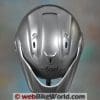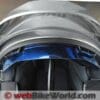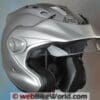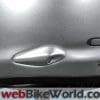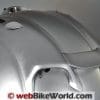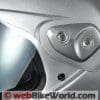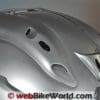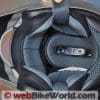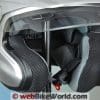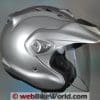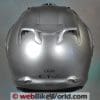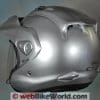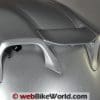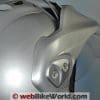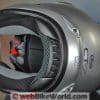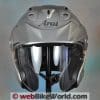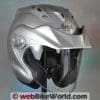The new Arai CT-Z is an evolution of the Arai XC RAM version of the Arai XC open-face helmet.
The CT-Z is a typical Arai helmet, with outstanding build quality…and a high price.
It’s a cross between an open-face and dual-sport helmet, with some full-face and trials helmet features sprinkled in for good measure.
The peak doesn’t add much besides styling but the new extended cheek/jaw protection are a plus.
The CT-Z makes an excellent touring helmet but it’s also a good solution for dual-sport owners looking for a more open helmet design with superior ventilation.
Arai is a conservative helmet manufacturer, priding themselves on a “decades long tradition of improving on what works”, as stated in their marketing literature.
Each new helmet in the Arai lineup is a careful iteration of what came before. Features like vents, liners padding and face shields are used across several different models.
You rarely see a revolutionary helmet design from this company, and that is either a plus or a minus, depending on your point of view.
I can understand the business logic of this strategy — no problem there.
However, if you think that the clever use of these features across the product lineup would help keep costs down, well, apparently that isn’t so, because the CT-Z carries a list price of $599.95. Ouch.
I’m not sure what the market is for six-hundred-buck open-face helmets, but I guess Arai will find that out soon enough.
In the meantime, it’s a very nice helmet, although I remain puzzled as to the utility of the “peak” on top. Yes, it adds something to the styling; open-face helmets without one always look half-finished to me.
But it doesn’t help all that much with sun glare; it makes ventilation more complicated; and it adds some noise to the mix.
Is it my favorite open-face helmet? The short answer is “Yes”. If I had to wear an open-face helmet, this would be it. Let’s take a closer look…
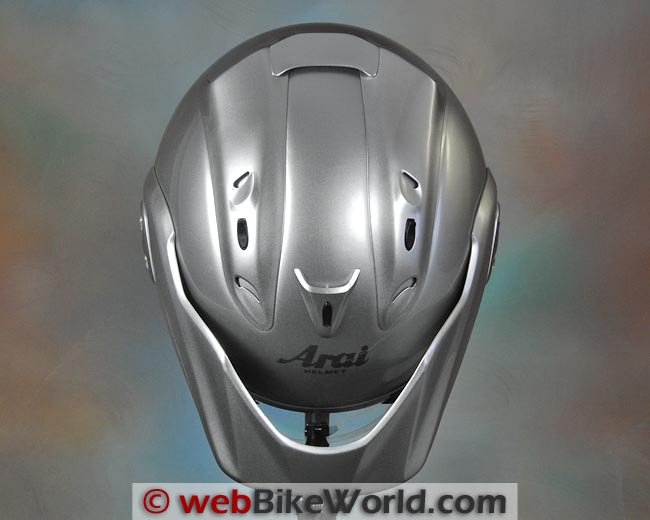
The Arai CT-Z: Paint, Graphics and Overall Quality
You could cut the text from this section of any webBikeWorld Arai helmet review and paste it here and you’d be just fine, because if Arai quality is one thing, it’s consistent. As in consistently good.
Paying the Arai price means getting superb quality, there’s no question about that.
The paint, the moving parts and the overall feel of the CT-Z exudes quality…just like it does on every other Arai helmet.
Of course, at these prices, it not only should, it would be a disaster if it didn’t.
Arai being the conservative company that it is, the CT-Z is available in your basic every-day button-down color choices of white, black and silver. OK, so they call it “Aluminum Silver”, “Black Frost”, “Diamond Black” and “Diamond White”.
Hey Arai: Where’s the red, yellow, orange, high-viz and blue — not to mention graphics?
The CT-Z is a perfect fit for the Gold Wing market and — not to stereotype the Gold Wing riders — but I’ve seen more than one rider and pillion with helmets color-matched to their bike.
A yellow or high-viz CT-Z would really spice up the recipe.
The liner and vents on the CT-Z are standard Arai, with the ventilation system copied from the Arai Corsair V (review), according to the company. The small vent rockers are used on every modern Arai helmet.
And like every other Arai helmet, they’re a bit too small, but they work well, smartly snapping open or closed.
The CT-Z face shield isn’t a carryover from an Arai full-face, but it incorporates the same type of Arai brow vents, which direct air into the top of the helmet through special vent channels built into the brow at the top of the eye port.
All good stuff, all very nicely put together and it all works beautifully, so no complaints here — you pick up an Arai helmet; you know it’a an Arai helmet. It’s what you pay for.
Score: I’ll give the Arai CT-Z an “Outstanding” rating for paint and overall build quality. See the Summary Table at the bottom of the page for a description of our rating system.
Arai CT-Z Helmet Fit, Internal Shape and Liner
Arai is still the only motorcycle helmet manufacturer we’re aware of that actually makes helmets with different internal shapes to (somewhat) match human head shape types.
Granted, the Arai shapes have “evolved” over the last couple of years and are all now much closer to what we call “Neutral” than they were in the past.
For example, the old “Round Oval” of the Quantum II (review) is gone (in North America, anyway), replaced by the “Intermediate Oval” of the Arai RX-Q (review) and…the CT-Z.
The CT-Z feels very much like the RX-Q; I know this because the RX-Q is my every-day “go-to” helmet.
I own one in size L and one in XL and the XL fits my “Earth” shaped head about as perfectly as I could hope for and better than any other helmet I’ve ever tried — and we’ve reviewed 197 (including this one) to date.
The liner and padding used in the CT-Z feels just like the RX-Q…although the fabric feels a bit softer this time around; perhaps another feature that has been evolved in the Arai continuous improvement loop.
The bottom line here is that if you fit into an Arai RX-Q, or perhaps even an Arai Signet-Q (review), chances are the same size CT-Z will have an identical fit and feel.
The Signet-Q does have a bit more room in the forehead, however, with its recently revised (read: closer to Neutral) internal shape.
The CT-Z fit is about as “Neutral” as you’ll find; it fits a slightly narrow head shape (ideal, according to Arai) but I’m living proof that it also works very nicely with a rounder head shape.
So “Neutral” it is in the webBikeWorld Motorcycle Helmet Shapes page rating system.
Also, my eyeglasses fit with no problems in the CT-Z; see the Randolph Engineering Aviator sunglasses review for more information.
The CT-Z employs another recently introduced Arai feature: the 5 mm thick “peel away” pads in the cheeks and in the sides of the helmet liner. This allows for some customization of the fit — an excellent idea.
The Arai size chart provided to the retailers shows a large fitting a 59-60 cm head and an XL fitting a 61-62 cm head.
This seems exactly correct and, of course, I fall right in between the range with a 60.5 cm round or “Earth” shaped (widest at the temples) head.
I bought a size large CT-Z, figuring that the open-face design would flex enough to make up the difference. But the relatively stiff shell, which meets both DOT standards and is Snell approved in the U.S.A., doesn’t flex as much as I’d hoped.
The size large fits me — it’s a bit snug but it works. I’m guessing that the XL uses the next larger shell size, and I’m opting for a slimmer external look instead, so I’ll stick with the size L.
Moral of the story? The CT-Z in size large fits just like you’d expect from a standard “Neutral” shaped size large helmet, so you’re probably safe ordering your normal size.
The padding and the fabric used in the removable helmet liner are comfortable and of high quality. The padding feels relatively plush and there are no edges or hard corners in this helmet; quite a difference from those cheap open-face designs.

More information on helmet fit can be found in the webBikeWorld Motorcycle Helmet FAQ page, along with the chart that lists the helmet weights of webBikeWorld reviewed helmets and also by shape on the webBikeWorld Motorcycle Helmet Shapes page.
Score: I’ll give the Arai CT-Z an “Outstanding” rating for fit, comfort, liner, padding and the ability to customize the fit with removable pads. The internal shape should fit motorcyclists with head shapes ranging from neutral to round.
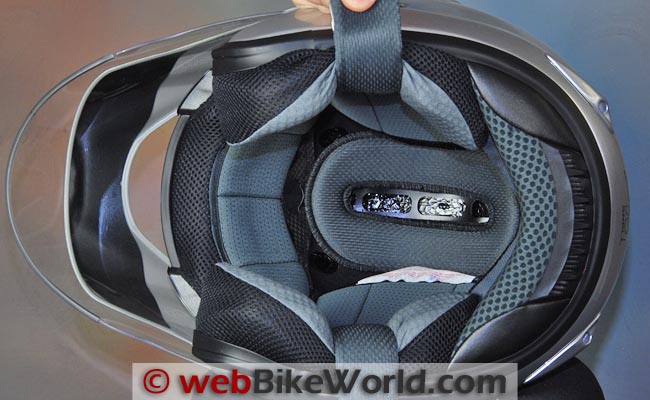
Arai CT-Z Eye Port and Visibility
One thing about an open-face helmet: no problem with visibility, that’s for sure! In fact, I’d hazard a guess that this single feature is what attracts many riders to this helmet design.
If you’re used to riding with a full-face helmet (like me), the first ride with a helmet like the CT-Z is a revelation.
If only a full-face helmet could provide this amount of visibility! It’s a definite safety factor and it lessens the claustrophobic feeling that some motorcyclists have.
The big face shield on the CT-Z covers almost the entire face. My chin sticks out the bottom, but those 30 mm longer sides that protect the jaw help to make the helmet feel almost sort-of like a full-face.
The visibility is unhindered out the bottom and I can barely see the side and top of the eye port, so the visibility in the horizontal and vertical planes is about as good as you’ll ever find on anything calling itself a motorcycle helmet.
It would have been even better if Arai had made the face shield a bit longer, or perhaps to offer a longer version as an option.
But nevertheless, it provides a lot of coverage and it’s one of the only open-face helmets I can wear on a motorcycle without a fairing or windscreen without feeling like a tornado is battering my face.
A curious thing about the face shield though: at low speeds (30 MPH or less) on a bike without a windscreen, there’s a vacuum effect that occurs, sucking in the surrounding bugs and blowing them up on to my face.
The solution is speed; once I get over 40 MPH or so, the aerodynamics come into play and create a sort of “bubble” that stops this from happening.
The face shield lifts through what feel like three subtle detents as it’s raised.
This is different than other Arai helmets, which use a friction system without detents. The face shield on the CT-Z will only open as far as the adjustable peak allows, however.
The face shield also has the dual Arai vents at the top, which don’t seem as effective on this helmet, probably because quite a bit of air flows up from underneath, due to the design.
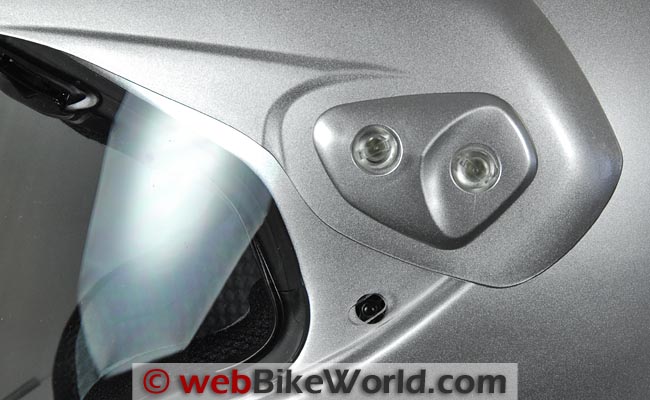
The Peak
The most distinguishing characteristic of the CT-Z is, of course, the peak, which was added to the top of the evolved Arai XC RAM to create this new design.
I have always been puzzled at the utility of the peak, whether it’s on an off-road helmet, dual-sport helmet or the weirdly strange Icon Variant (review).
It doesn’t really offer very much protection from the sun’s glare and it almost always creates its own aerodynamic problems for the rider.
About the only thing it really does is give a different look to a helmet, and in the case of the CT-Z (nee XC RAM), that’s not such a bad idea.
The CT-Z is sort of an open-face version of a dual-sport helmet and with the huge popularity of dual-sport and adventure-touring motorcycles, that’s a pretty clever marketing trick by Arai.
There’s no reason why a CT-Z couldn’t be used as a dual-sport helmet and it almost certainly has better ventilation than any full-face dual-sport helmet you’ll find — just hope you don’t do a face plant on a rock when you’re out in the boonies.
The peak of the CT-Z gives a bit of protection from the sun’s glare, but only when the sun is directly overhead.
That huge face shield and equally huge amount of forward visibility is a bit of a liability when old Sol is positioned at the upper edges, like 10 and 2 o’clock.
It causes a lot of glare and it’s no match even for my pair of very dark Randolph Engineering Aviator sunglasses (review).
This is one helmet that could definitely use at least a short internal sun visor to block the glare, but don’t count on Arai adding that any time soon.
So you’ll need either an “el Cheapo Sun Blocker” (review) or a Sunax Sun Shield for Arai (review)(although I’m not sure if their Arai version will fit the CT-Z, I’ve contacted the company to find out).
The good news is that the peak on the CT-Z doesn’t add much lift, nor does it affect the aerodynamics of the helmet very much.
I can feel a bit more pressure on the helmet when I turn my head at speed or if there’s a cross-wind, but it’s mild and not as dramatic as other “peaked” helmets I’ve worn.
UPDATE: We have confirmed that the Sunax Max Sunshield (review) fits the Arai CT-Z and this helps reduce the overhead glare in this helmet.

Score: The Arai CT-Z gets an “Outstanding” rating for visibility, no question about that.
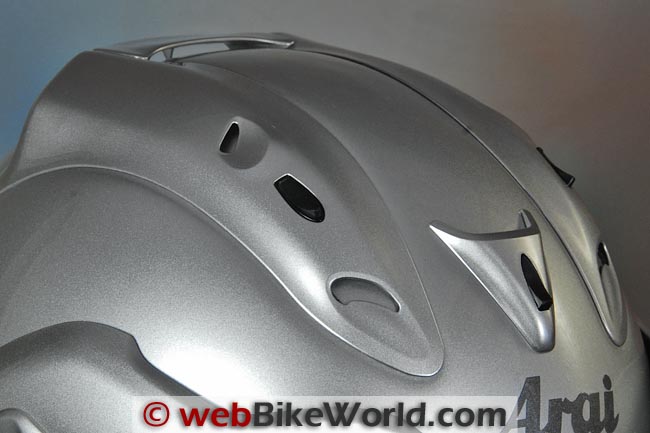
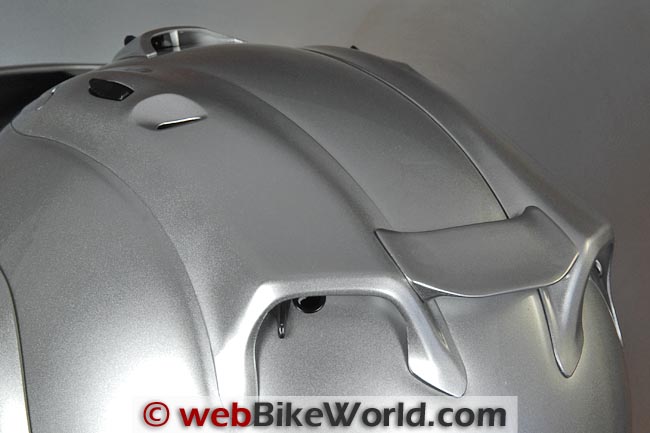
Arai CT-Z Ventilation
The upper ventilation system of the CT-Z was cribbed from the Corsair V (review) race helmet, according to Arai. That’s not a bad thing, because the ventilation on the Corsair V is pretty good.
It works on the CT-Z, bringing cool air down into the helmet, where it exhausts out the back through the two large ports.
The exhaust vents have the Arai sliding lever covers, but does anyone ever close them? I’m not sure why you would, even in cold weather.
Three of the tiny Arai rocker switches work the intakes in front. The center intake vent opens towards the rear, probably to help reduce noise, although ironically, this one is louder than the two on the sides.
The system, with its added-on plastic assembly, is a bit of a throwback to the days when a race helmet had to have a big top “aerodynamic” structure like this to look the part.
It’s nicely designed and well made on the CT-Z, but it does still look a bit like an add-on. But, it works, and that’s what matters.
The face shield has two eyebrow vents at the top that open to guide air into ports in the liner, but these don’t seem to be as effective as they are on the RX-Q, probably because of the air that flows up from under the face shield on the CT-Z.
You’ll get a lot of air flow from underneath in the front whether you want it or not, but that’s the price you pay with an open-face helmet.
It’s not as bad as others I’ve worn though and this is the first open-face helmet I can wear for extended periods on an unfaired bike.
Burn and I also swapped for the CT-Z on his now-antique BMW K1100LT with its big touring screen and that’s where the helmet comes into its own. The design is ideal for a touring bike.
So the bottom line here is that the Arai CT-Z ventilation system works.

Score: I’ll give the Arai CT-Z ventilation system an “Outstanding” overall rating.
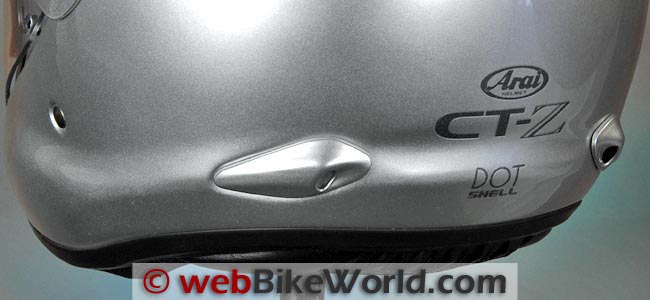
Arai CT-Z Sound Levels
The CT-Z is actually pretty quiet, all things considered, and that’s a surprise to me.
Those wider, larger cheek/jaw protectors help to cradle the side of the head and the ears and that, combined with the internal shape and the big ear pockets and thick padding, block a lot of noise that would otherwise intrude.
The air streams smoothly over the helmet and the only real noisemakers are the top vents.
The center vent seems to be the culprit, it can generate some whistling noises at speed, although overall, it’s still better than average.
That an open-face helmet is quieter than many full-face designs is a bit of a surprise, but careful attention to detail helps here, as does the tight-fitting face shield that doesn’t allow any air to leak in along the sides.
Fitting an Intercom to the Arai CT-Z
The ear pockets of the CT-Z seem relatively deep and they fit standard intercom speakers. The helmet shell also allows a standard intercom mounting bracket to be fitted also.
This was probably a deliberate design move by Arai, because surely the CT-Z is aimed at the touring rider and the intercom is an important component for two-up touring.
We were able to squeeze an Interphone F5 (review) bracket to the CT-Z and easily fitted the nice metal bracket from the Sena SMH-5 (review) to the helmet.
So overall, the noise levels of the Arai CT-Z are lower than average with some general wind noise around the top of the helmet but otherwise commendable, especially for an open-face design. It’s borderline, but I’ll rate it as slightly quieter than average.

Note that our helmet evaluations are a combined effort of several riders over time on different types of motorcycles with and without windscreens.
Evaluators wear correctly fitted, high quality ear plugs (even when evaluating motorcycle intercom systems).
Always protect your hearing when riding a motorcycle. See the wBW Earplug Reviews for more information on choosing and wearing earplugs.
Note also that perceived noise levels will vary, depending on the individual.
Noise can be caused by many factors, including helmet fit, the type of motorcycle and windscreen, wind speed and direction and even the rider’s clothing.
For more information on helmet noise, visit the wBW Motorcycle Helmet Noise page.
Score: I’ll give the Arai CT-Z an “Excellent” rating for good noise control.
Helmet Weight
The CT-Z is actually fairly heavy for an open-face helmet. The size large shown here weighs 1564 grams, making it the heaviest open-face helmet we’ve reviewed on webBikeWorld.com.
Compared to full-face helmets, the CT-Z currently ranks as number 46 out of 198 helmets. There are many full-face helmets that are lighter and more that are heavier.
Here are some random comparisons from a few helmets listed on the wBW Motorcycle Helmet Weights page.
The AFX FX-50, which has the same type of “open-face dual-sport” design as the CT-Z, weighs 1525 grams in size large and we rated that helmet as “heavy”.
The Bell Star (full-face) in size large weighs 1559 grams; the HJC IS-Multi, also in size large weighs 1560 grams and the Caberg Ego, an interesting market competitor of the CT-Z, weighs in at 1567 grams in size large.
The CT-Z is nicely balanced though, so the weight is evenly distributed and doesn’t pose any issues.
Note also that all of the helmets reviewed on webBikeWorld have been weighed and the weights are available on the wBW Motorcycle Helmet Weights page, along with a chart that lists the helmets by weight and shape on the wBW Motorcycle Helmet Shapes page.
Score: The Arai CT-Z gets a “Very Good” rating for weight with good balance.
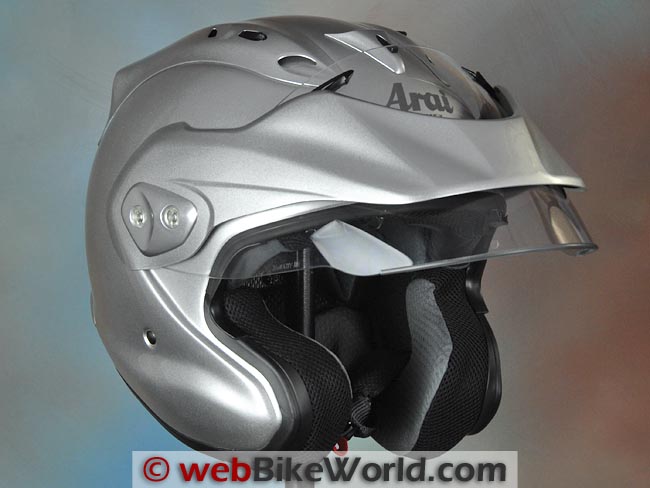
Miscellaneous
The CT-Z has a double D-ring chin strap. Ironically, this type of helmet could probably benefit by a “Microlock” type system for the touring rider.
But in what has become a strange Arai tradition, the padding under the chin strap is again way too short and the nylon webbing can irritate the neck.
Why Arai insists on making such short chin strap pads is a mystery. This issue definitely needs addressing, Arai, as it is a problem with every modern Arai helmet.
The CT-Z is apparently only available in the North American market. It meets the DOT standard and it’s Snell approved. The helmet carries the standard Arai five-year warranty, which effectively covers the helmet for its usable life.
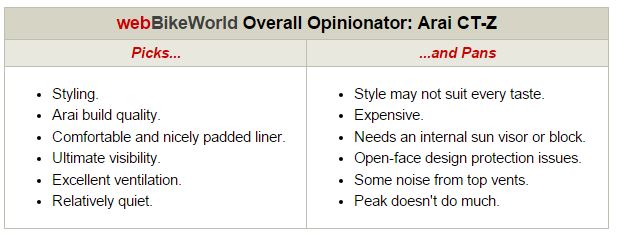
Conclusion
The Arai CT-Z is a nice helmet with outstanding build quality. It’s also comfortable and it has the potential of providing better protection than most or all other open-face helmets available today.
The visibility is second to none and the helmet has excellent ventilation. It’s not without a couple of flaws though. The amount of glare from the sun can be annoying, depending on the rider’s sensitivity to light.
The helmet definitely needs some type of sun shade or sun block, and this will most likely have to be solved by owner ingenuity.
But otherwise, if you like the design, the CT-Z makes an excellent helmet for touring or even dual-sport riding. It will be interesting to learn if buyers are willing to shell out $600 for this helmet. Let us know what you think…
By the way, if you’re looking for a somewhat similar design, read our AFX FX-50 review. You can buy one for $85.00!
| wBW Review: Arai CT-Z Helmet | |
|---|---|
| Manufacturer: Arai Helmets | List Price: $599.00 (Solid colors). |
| Colors: Aluminum Silver, Black Frost, Diamond Black, Diamond White. | Made In: Japan |
| Sizes: XS-2XL Shell Sizes: Unknown | Review Date: September 2012 |
|
Rating Scale is subjective: Unacceptable, Poor, Neutral, Very Good, Excellent, Outstanding.
|
|
Owner Comments and Feedback
See details on submitting comments.
From “F.M.” (February 2015): “I bought one of these last year and it is by far the best Arai open face of the three models I have now owned.
It is very quiet, mostly due to the snug fit around the lower jaw area and very comfortable on my head. Doesn’t feel heavy, even after hours of wear.
The increased chin protection, over past Arai open face models is a welcome change and to me, this would appear to be the ultimate open face helmet. Very happy with my expensive (but what is your head worth) Arai CT-Z helmet.
Update from “F.M.” (April 2015): “I recently purchased and installed the Sunax Max Sunshield (review), as mentioned in the review of this helmet and it is a great addition to a great helmet.
It cuts out sun glare that is coming from one or two o’clock ahead of you and if the sun is lower on the horizon, tipping your head forward a bit brings the shield into your line of vision, allowing you to see clearly, without squinting, through the shield.
Easy installation without any tools, but I used some white photographic gloves to keep the shield free of fingerprints during installation.
Easier than trying to clean it once in place, since it is only held in by the slight pressure between the shell/liner interface.”
From “P.W.” (January 2015): “I have been using the CT-Z for over a year, and have reached exactly the same conclusions as the reviewer. It is a brilliant helmet for me, although a retractable tinted eye shield would be very useful when riding into the sun.
The major failing for me however, is that while the Arai face shield comes Pinlock ready, Pinlock do not have (or didn’t, 6 months ago) a Pinlock shield to fit, which means it is less than satisfactory on those cold winter mornings.
I am at a loss to understand how a company as professional as Arai could release a Pinlock ready face shield, and advertise it as a feature, when you can’t buy a Pinlock shield to fit.”


